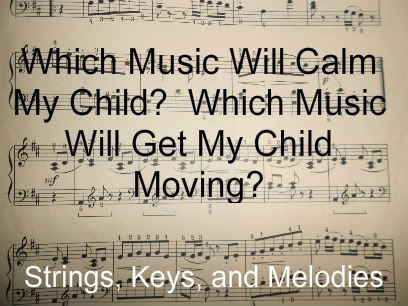Music has the ability to change our feelings and
behaviors. Slow, soft music can make us
feel calm and relaxed. While fast music
with a lot of rhythm can make us feel energized and get us dancing. Parents have asked me to suggest music for
their child to listen to while falling asleep or to get them moving.
We all know each person is made up of body, mind and
spirit. Did you know that music is made
of three components that match those parts?
The three parts of music are rhythm, melody, and harmony.
Rhythm affects
our body and stimulates our arms and legs.
Percussion is the group in the orchestra that provides rhythm. Percussion instruments include the drums,
cymbals and shakers.
Melody affects
our mind and stimulates our head. The
woodwind instruments, such as the flute, clarinet, and oboe provide
melody.
Harmony affects our spirit and touches our
hearts. The string instruments provide
the harmony in the orchestra. Violin,
viola and cello are string instruments.
The goal is to select music to stimulate or calm the body,
mind and spirit in order to create balance.
Not everyone will react the same way to a piece of
music. So I can suggest pieces to play
for your child but you will have to see her reaction to it to determine if it
is right for her.
Most of these suggestions are classical music and that is
because classical music usually contains all three parts: rhythm, melody and harmony that is necessary
for balance.
Stimulating Music
Children who are lethargic or have weak limbs need to be
stimulated with rhythm. They need
rhythmic percussion to invigorate them.
For children with weak muscles and limbs and to energize
sleepy bodies play stimulating music with the volume slightly louder than
usual.
“Bolero” by Ravel-orchestra
“Mephisto Waltz” by Liszt – piano
“Stars and Stripes Forever” by Sousa-marching band
“German Dance” by Mozart- orchestra
“The Toy Symphony” by Leopold Mozart-orchestra with horn and
glockenspiel calling out “cuckoo”
Calming Music
Hyperactive children can be calmed by playing music with
more melody and harmony and less rhythm and percussion. Instead of being physically and mentally
active she will be relaxed and soothed.
“Romeo and Juliet” by Tchaikovsky-symphony orchestra
“Carmen Suite” Nos. 1-2 by Bizet – orchestra with a lot of
wind instruments
“Andantino from the Flute Quartet in C Major” by
Mozart-orchestra with a lot of flutes
Music for Anxiety
Anxious children respond well to music that has pronounced
rhythm and melody
Waltzes by Strauss- orchestra
Anything by Mozart but you can start with the “Adagio from
the Divertimento in B Flat (K. 287)” The Italian word adagio means “to
put at ease”.
Music for Chronically Ill
Soft music is wonderful for chronically ill children
“La Mer” by Debussy-orchestra
“Andantino from the Flute Quartet in C Major (K.171)” by
Mozart-orchestra
Music for Emotionally Sensitive Children
Children who are emotionally sensitive need a lot of harmony
in music.
“Jupiter Symphony” by Mozart-orchestra
My Favorite Sleeping Music.
Classical music has a calming effect that helps children
fall asleep.
Some studies also show playing classical music as children
are falling asleep and waking up can reduce the incidences of seizures since
episodes frequently occur just before or after falling asleep and soon after
awakening.
My girls’ favorite nighttime music is “Classical Naptime for
Tots”. It has a variety of classics from
Bach, Debussy, Beethoven and Puccini
They also love Jewel’s Lullaby CD from Fisher Price
My Favorite Stimulating Music
“Jazz for Kids” is a favorite to play while using all kinds
of rhythm instruments like sticks, bells and maracas. It features Jazz greats such as Ella
Fitzgerald and Louis Armstrong singing child friendly jazz songs.
“First Steps in Classical Music: Keeping the Beat!” is a favorite full of
classical pieces to play with rhythm instruments.
Everyone has different musical preferences. Try these
suggestions and see how your family responds. If the song doesn’t work for you and your
child then skip it and move on to another piece. In order to save costs, you can find most of
these songs on You Tube and these CD’s at the local library.


This is a great post! I plan to play background music in my classroom during down times such as snack time, so this is a great list to start with!
ReplyDeleteThanks Angel! You'll have to tell me which music works best for your classroom! Thanks for reading.
DeleteI've never thought of body, mind, spirit, connecting with rhythm, harmony and melody. That's a great way to think of it. I love the lists too.
ReplyDeleteOh, you know so much about this. I didn't know it was so complicated but this helps me understand why sometimes my music selections didn't help in the way I wanted. This is something I will save, and I could label music with some information for quick selection. This information is helful and impressive. Thank you so much. Carolyn
ReplyDeleteyou should visit toques para iphone to find the answer.
ReplyDelete